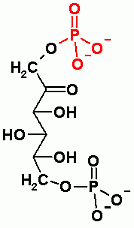

If all enzymes behaved with simple Michaelis / Menten kinetics there would be some potential conflicts in activities. For instance, take a closer look the two reactions catalyzed by different enzymes in the glycolytic and gluconeogenesis pathways:
 | ||||
 | ||||
If these two enzymes were allowed to "go at it" unchecked then one could potentially see a cyclic reaction where PFK-1 would use an ATP to make fructose-1,6-Bisphosphate and then FBPase would hydrolyze the phosphate to yield fructose-6-P once more. The end result of these two reactions is simply the hydrolysis of ATP and nothing else. When two enzyme reactions could potentially be involved to perform no useful work but to hydrolyze ATP instead (with no obvious useful results) this is termed a "futile cycle". There are many such points in metabolism and they all need to be painstakingly regulated to minimize the potential energy loss.
Fortunately, some enzymes (these two in particular) do not adhere strictly to the Michaelis / Menten Kinetics scheme that was outlined in module 4. Their properties of kcat and Km can be radically altered in response to physiological conditions.
One example of a change in physiological conditions is linked to relative [ATP] in the cell. For instance think about muscle cells that are being worked hard vs. ones that are in a state of rest.
Muscle contraction requires ATP hydrolysis to ADP and PO4=. Therefore, it is logical to assume that in a hard working muscle cell the [ATP] will be low relative to the [ADP]. Under these conditions one demands more glycolysis to ensure the constant energy input necessary to keep synthesizing ATP. Which pathway do you NEED to be operating fastest? Obviously the glycolysis pathway. It makes no sense under these conditions to be putting energy into glucose synthesis because the demand is for muscle contraction.
Here the demand for ATP for contraction is low. It is logical to assume here that - relatively speaking - the [ATP] is high. Since the demand for ATP for contraction is low it can go toward other important matters. Such as glucose synthesis, protein synthesis cell reproduction etc. etc. Of the glycolysis and gluconeogenesis which would be most advantageous now? There is no need to make more ATP it is best used to make stuff so gluconeogenesis should be the fastest of the two.
Note: it turns out that muscle tissue, itself, does not do gluconeogenesis very much (It's actually performed mostly in the liver) But I use this to illustrate the problem.
So the relative concentrations of ATP and ADP then are effective indicators of physiological state. When [ATP] is low make more. when [ATP] is high use it for synthetic purposes. Therefore it would be logical if ATP (or ADP) were used to directly signal what is needed. Indeed ATP and ADP bind to the allosteric site of both PFK-1 and FBPase and alters their activity